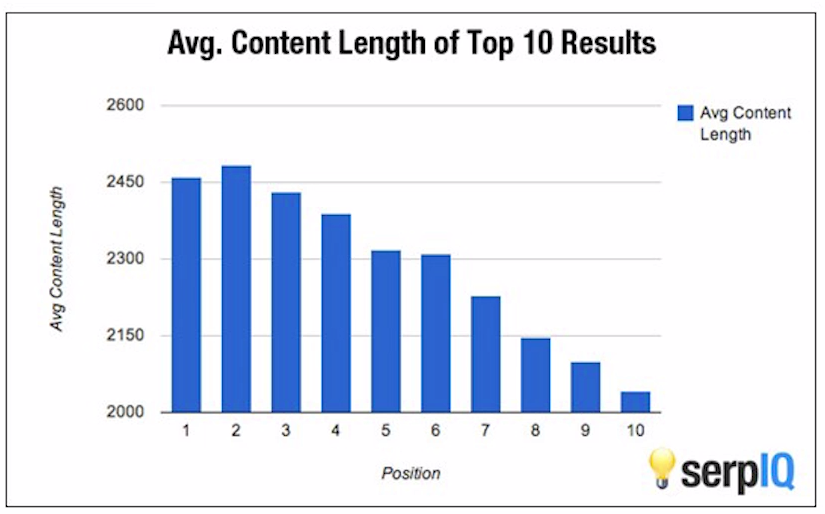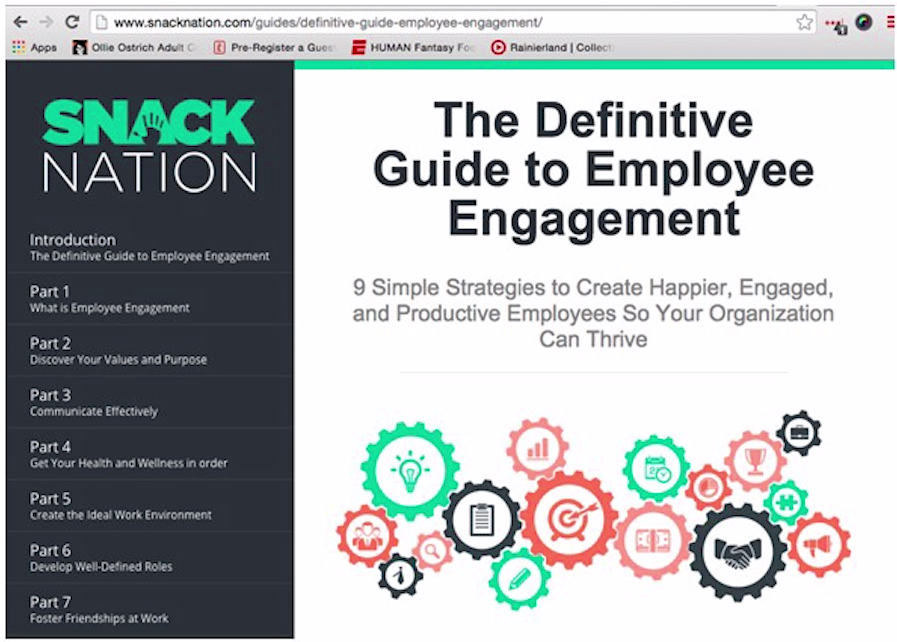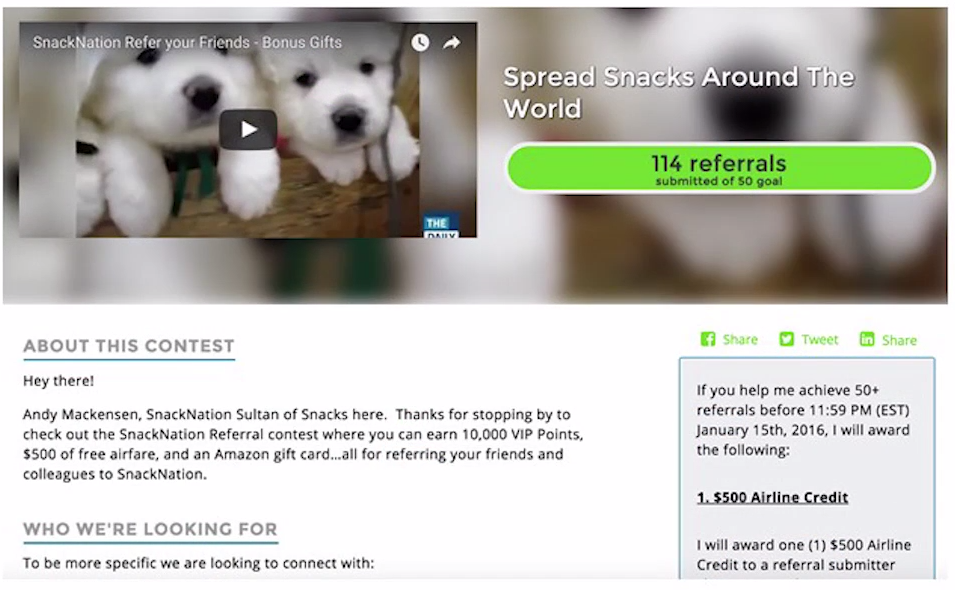Building a top-notch marketing machine isn’t easy—but harnessing the power of your customer advocates will help. Andy Mackensen, Co-Founder and CMO of HUMAN and SnackNation, gives his top seven tips for creating amazing marketing content that will generate lots of evergreen leads. (Hint: start talking to your advocates!)
Who’s ready to talk about some smart marketing hacks? I have seven surefire strategies to build brand, generate demand, and grow revenue by 1,200%. My main goal for you is to walk away with seven actionable items that you can take back to your company and implement immediately.
Who is Andy Mackensen? In my past life I was a decorated officer in the U.S. Navy. I did a couple of deployments over to the Persian Gulf, including 2003 at the beginning of the Iraq war. I knew I didn’t want to stay in the Navy forever, and I was a serial entrepreneur before the Navy with lawn-mowing businesses and snow-blowing businesses and whatnot.
In 2008, I started HUMAN, which stands for Helping Unite Mankind And Nutrition. We were America’s first healthy vending company. In 2013 we made the Inc 500 “America’s Fastest Growing Companies” list at number 168.
In 2014, we launched Snack Nation on the heels of healthy vending. We realized that there were a lot of opportunities in offices, since, news flash, offices don’t really like vending machines. We developed a new platform: healthy snack delivery.
In August 2015, we launched our Influitive AdvocateHub. We also grew revenue 1,200% with Snack Nation. The bottom line here is that I’ve done a lot of things right, and I’ve also done a lot of things wrong… but building brand, generating demand and customer advocacy works.
Hack #1: Clearly define your brand
When we thought about the Snack Nation brand, we wrote down what we called our brand promise. What’s a brand promise? It’s who you are, what you do, and the compelling benefits your customer gets. It should always be customer-minded, customer-first thinking. It’s about being authentic, incredible and it’s a promise that must be kept every time.
Here’s an example from Snack Nation: “Snack Nation is the only healthy snack delivery service that helps companies create awesome offices by delivering a hassle-free and fun snacking experience that produces happier, healthier and more productive employees while creating first-time access to the world’s best emerging and innovative brands. With Snack Nation, your employees not only perform better, they also feel cared for and appreciated and are thrilled to discover new snack favorites before any of their friends.”
It’s a mouthful. We put all of the elements in there to make the full brand promise. We use different versions of that depending on where it’s placed. I wanted to get the full essence in the entire thing.
Let’s break it down. What’s our unique selling proposition? The unique selling proposition hack is to put the two words, “the only,” in front of a sentence. If you are “the only” company that does something, then you are in fact unique.
What is Snack Nation? We’re a healthy snack delivery service. What do we do? We help companies create awesome offices. How do we do it? By delivering a hassle-free and fun snacking experience. What does our customer get? All that stuff below.
Here’s the expert hack. When formulating your brand promise or reviewing your current brand promise, ask your customers. Put a challenge in your Influitive AdvocateHub and say, “Hey, what are the biggest benefits that our product or service provides to you?”.
Get feedback from your customers. If you get enough responses, you’ll start to see themes and words repeated. Pull those out and insert them in your brand promise.
Hack #2: Do keyword research like a boss
Keyword research is the foundation of demand gen. What are the keywords and hot buttons that your prospects are searching for? Again, ask your customers about the things they’re searching for. When you find out what those keywords are, based on your keyword research and that feedback from your customers, formulate and write your content around the keywords that matter most to your customers. That’s going to attract your best potential prospects. The biggest mistake that I see is kicking off a demand gen strategy without keyword clarity.
Let’s take a look at an example. We talk to our customers and because we are delivering healthy snacks, one of the main items that’s important to them is employee wellness. It’s not a direct hit on healthy snacks, but it’s tangential that healthy snacks can help provide employee wellness.
While looking at the keyword research, we saw that employee wellness is a massive keyword that’s incredibly competitive. We said, “No, we’re not going to compete on that in Google. Let’s go find the next tier of keywords.”
It was employee wellness ideas, which is still highly searched on and highly trafficked. We said, “All right, let’s create a monster blog post. It’s five times better than what currently exists on the first page of Google. We’ll call it 121 Wellness Program Ideas For Your Office.”
After some promotion and after some link building, we came up in the rankings. Now we’re sitting in the #1 organic spot for that blog post. That delivers 15,000 visits to our website a month, which in turn generates leads and of course deals.
Hack #3: Commit to kick-ass content
SerpIQ has done some research on the number of words in a blog post that get ranked. You can see that the top rankings on Google tend to have more words: an average of 2,450 words, in fact. If you’re going to go after SEO and you’re going to go after rankings and traffic, commit to amazing content that is at least 2,000+ words.
User experience and aesthetics are also super important. The reader has to enjoy what they’re seeing. Proper spacing, bolded subheadings, embedded videos and pictures. As you’re scrolling down that 3000-word blog post, there should always be bolding or pictures or videos. That helps the reader keep scrolling down.
Don’t have big blocks of words. People are scared of reading big blocks of words. Again, make it way better than your competitor’s content. We shoot for five times better. We want to absolutely blow the competition out of the water.
Spend a lot of time on that content. That’s what going to get it ranked. SEO is the gift that keeps on giving traffic and leads continuously.
Hack #4: Convert white papers into ungated online guides
We took a look at our most popular white papers, and instead of having a gated PDF, we converted them onto our website. This example on the screen is actually a monster. This is a 13-part, 92-page PDF that we converted over to online completely ungated.
We picked the keywords that we wanted to rank for. Employee engagement is in there. A lot of the keywords are, again, based on keyword research, so we know we want to rank for. We did a lot of promotion and link building around the content. Now that ungated content online gets ranked by Google and moves up in the rankings.
These are the early days of this guide, so I don’t have rankings on this yet, but based on some other guides we’ve done, it will move up slowly. You can get into that #1 position and generate evergreen traffic to the same guide that you had gated.
The question is, what’s the point? People are consuming the content, but I’m interested in leads. To do this, you put call to actions throughout that guide saying, “Hey, don’t want to read this all in one sitting?” Then, they can enter their email to download the PDF version so they can read it later.
The concept is that you’re getting the same result as before. You’re generating leads. What’s different is that you’ve got evergreen traffic continually hitting that page, so it’s an evergreen source of leads as opposed to having to drive people to an opt-in to go download a PDF.
In these guides, you should also ask your customers to contribute. We have a bunch of quotes from our customers about employee engagement. Include your advocates in your content.
Hack #5: Invest in customer advocacy early
Your first hire in customer success should be before you get to 10 employees. Invest in it early. Invest in it often. SaaStr recommends one CS hire for every $2 million ARR.
At Snack Nation, we ended up doing our first CS hire at $500,000 in ARR. We’ve been hiring one new rep every million in ARR. That’ll eventually move out to about every 2 million in ARR, but we’ve invested early. We’ve got a thriving team of customer success reps now.
Invest in tools like Influitive’s AdvocateHub. We invested in Influitive three months after Snack Nation started gaining traction because we saw the value in customer advocacy and got started on that early.
Of course you should also be measuring churn, number of referral leads and deals. We also measure how many video testimonial requests we get. We have a goal set around that. It’s also important to measure overall ROI for your AdvocateHub.
Hack #6: Create an evergreen referral system
What is an evergreen referral system? It’s a referral lead system on autopilot that keeps generating referral leads over and over again. We looked at our customer journey map and found strategic areas to insert referral asks along the journey.
Is it too soon to ask for a referral when someone opts in? We’ve experimented with putting social share buttons and some incentives on our “Thank You” page when you opt in. We ask people to, if they like what they’re seeing, tweet it out. Put it on Facebook. That’s an area that’s generated some referrals for us.
At the point of sale, if the sales rep has a really great experience and they think that the customer’s going to be a rock star, they ask them for a referral right after the deal’s done. Strike while the iron’s hot.
Our customer success team has check-ins at months one, two and three. We always gauge how things are going with our customer. We have questions that we ask. If the responses come back favorable, basically the equivalent of a 9 or a 10 on the NPS, our customer success team asks for referrals at that point as well.
Then, of course, we have quarterly email and promo contests. Influitive actually ran a beta contest couple months ago and it was pretty cool. They made a page for us. It said, “Set a goal,” so we set a goal of 50 referrals. For every referral that was submitted, the referrer got a $5 Amazon gift card. It was unlimited, so if you submitted 10 referrals you could get $50 in Amazon gift cards.
Then, we put everyone in a pool and did a raffle and there was one winner of $500 in airline credits. I sent an email out to our customer base in the beginning and we got about 45 referrals. I sent another email out a couple days before the deadline, and it went from 45 up to 114 referrals. This was over the course of 30 days. It literally took two emails, a cool contest and a platform to do this.
We’ve closed five deals on this contest and we still have a lot in the pipeline that we’re still working through. It’s pretty cool to think of a quarterly fun contest like this to run and set it on autopilot.
We drive all our people to the Influitive AdvocateHub to submit the referrals, so they’re tracked. The bottom line is just that people aren’t asking enough for referrals—so ask. Figure out more places in your customer journey map to ask.
Hack #7: Create a referral culture
Publicly praise people who are referring to your entire customer base. We call out our members to our entire membership base as well as privately praising and rewarding them. Every time we get a deal that comes in from a referral, I shoot an email off as a quick thank you. Then, I’ll send them a little surprise in the mail: a sample box of our snacks with 15 of our top snacks and a digital Starbucks gift card for $5.
Something that’s surprising and unexpected is really appreciated. If you do those kind of things, they’re going to keep referring.
You should also be doing a newsletter call out. If you have a monthly or quarterly newsletter, plug in a section to make sure that you’re calling out the people who referred. Call them out in the Influitive AdvocateHub, too. Put a challenge up in your program and give people 25 points, just for reading something that says, “Hey, congratulations to these customers for sending us referral leads.”
It’s about finding all the different touch points and all the different mediums to reward and praise. That in turn builds a referral culture.













































